Page Scales and Viewports
Page scales are used to ensure the accuracy of measurements and takeoffs. The page scale must be set before any measurements are taken and, if it is not, Revu will prompt you to set it the first time you try to place a measurement.
Viewports are zones in a drawing that use different scales. Multiple viewports can be set for a drawing.
Page scales ensure the accuracy of measurements placed on the drawing; without them, Revu cannot calculate real values for measurements. The page scale can be calibrated to the drawing (recommended) or input manually.
There are several ways within Revu to set the page scale, including the Calibrate tool in the Tools menu and on the Measurements Panel or Thumbnails Panel. If the page scale is not set when you try to take a measurement (with the exception of a Count), the Set Scale dialog box appears prompting you to set it.
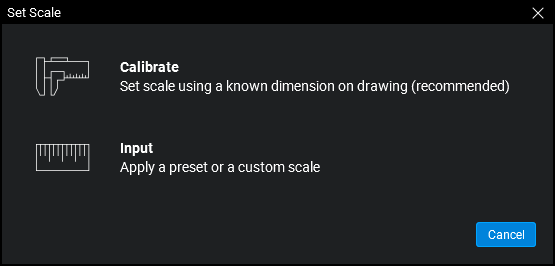
Select a method, Calibrate or Input, to set the page scale.
Calibrates the document to allow accurate measurements to be taken by measuring the length between a known distance on the drawing.
- A dialog box might appear with instructions regarding the use of the Calibrate tool. If it does, click OK.
-
Locate a measured length on the page. Click the first point of the known length, then click the second point to finish the line. Hold down SHIFT to snap the two points horizontally, vertically, or diagonally (as appropriate). When the second point is selected, the Calibration dialog box opens.
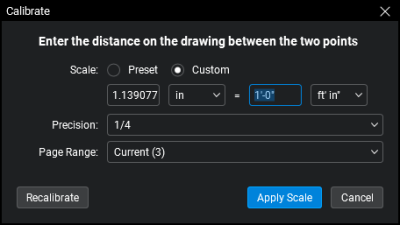
-
Enter the distance that the line between these two points represents on the drawing and select the units in which measurements are to be reported.
- Select the decimal or fractional precision of the measurement values from the Precision menu.
- Select the Page Range to which to apply this scale. Each page in a drawing can have its own scale.
- Click OK.
If the page scale is known and you are certain no scaling has occurred during the PDF creation process, you can input a page scale manually.
-
Select the desired input method: Preset for common scales or Custom to manually input a non-standard scale.
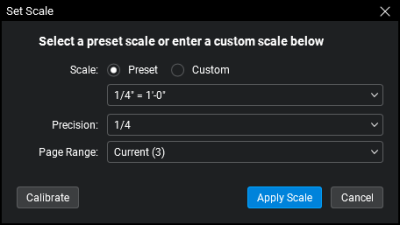
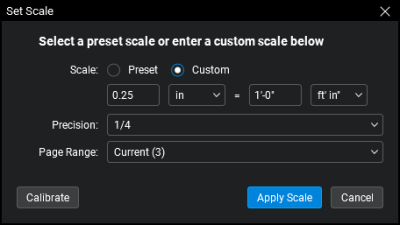
- For Preset, select the desired scale from the menu below. For Custom, enter the scale in the fields below.
- Select the decimal or fractional precision of the measurement values from the Precision menu.
- Select the Page Range to which to apply this scale. Each page in a drawing can have its own scale.
- Click OK.
- Open the desired PDF.
- Go to Window > Panels >
 Measurements or press ALT+U to show the
Measurements or press ALT+U to show the  Measurements panel.
Measurements panel. -
Click
 Add Viewport in the Viewports section.
Add Viewport in the Viewports section.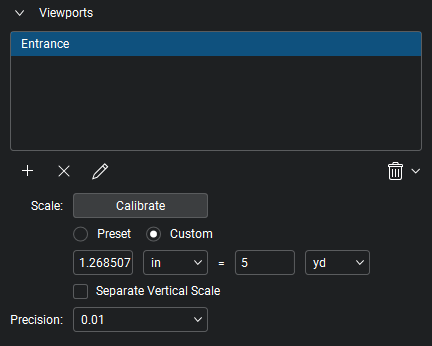
- Click and drag a rectangle around the desired viewport area, then enter a name for the viewport in the dialog box that appears.
- Hold down SHIFT while defining the viewport to draw a square.
- Click Calibrate in the Viewports section and select two points within the viewport to define its scale. Viewports that are not calibrated are automatically set at the document's default scale.
- Viewports can have separate X and Y scales, if desired. Select Separate Vertical Scale to enable this option. The process for calibrating separate scales is the same as for the PDF itself. See Calibrating Separate X and Y Scales for more information.
- Select the measurement precision for the viewport from the Precision dropdown menu.
When a measurement is placed on a PDF that has viewports, they are automatically highlighted and their associated scales are shown. To highlight a specific viewport, select it from the Viewports list and the viewport area, name and scale will appear in the drawing.
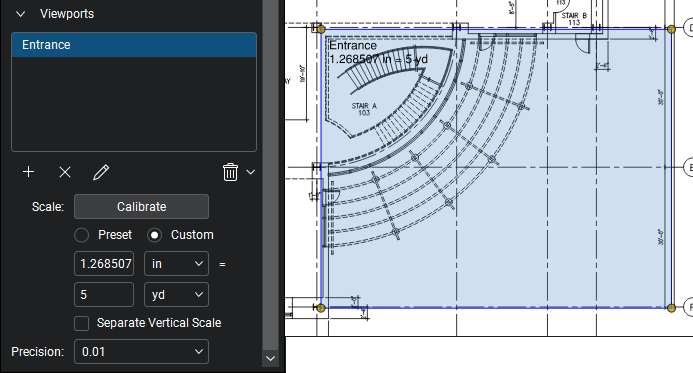
Note: If you notice a viewport that is untitled, this could be affecting the accuracy of your measurements in that area. In this case, the untitled viewport should be deleted.
To modify the scale or scale options of a viewport, select it from the Viewports list and make the desired changes. You can recalibrate the viewport (by either clicking Calibrate or entering the new scale manually).
To change the name of a viewport, select it from the list and click  Rename Viewport.
Rename Viewport.
To remove a specific viewport, select it from the list and click  Delete Viewport.
Delete Viewport.
To remove all viewports on either the current page or in the entire document, select the appropriate option from the  Clear All menu:
Clear All menu:
Clear All from Page: Removes all viewports on the current page.
Clear All from Document: Removes all viewports in the document.